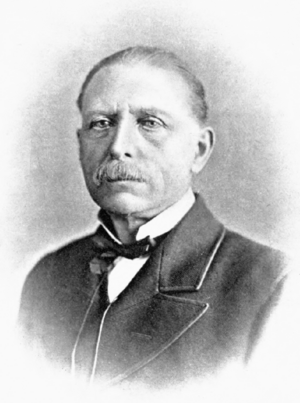Robert Alfred Cloyne Godwin-Austen facts for kids
Robert Alfred Cloyne Godwin-Austen (born March 17, 1808 – died November 25, 1884) was an important English geologist. Geologists are scientists who study the Earth's rocks, how they formed, and how the Earth has changed over time. He was also a Fellow of the Royal Society, which is a special group of top scientists.
Contents
Early Life and Education
Robert Alfred Cloyne Godwin-Austen was the oldest son of Sir Henry E. Austen. He went to Oriel College, Oxford, which is a famous university. In 1830, he became a fellow there, meaning he was a senior member of the college. Later, he studied law at Lincoln's Inn.
In 1833, he married the daughter of Major General Sir Henry Godwin. In 1854, he added "Godwin" to his last name, becoming Godwin-Austen.
His Start in Geology
While at Oxford, Robert Godwin-Austen was a student of William Buckland, a famous geologist. This sparked his deep interest in geology. Soon after, he met and was inspired by Henry De la Beche, another well-known geologist.
Godwin-Austen helped De la Beche by creating a geological map of the area around Newton Abbot in Devon. This map was later included in the official Geological Survey maps. He also wrote a detailed paper called On the Geology of the South-East of Devonshire, which was published in a geology journal.
Important Discoveries and Ideas
Godwin-Austen then focused his studies on the Cretaceous rocks in Surrey, which was his home county. His family's estates were located in Chilworth and Shalford, near Guildford.
He also studied the loose layers of rock and soil found near the English Channel. He looked at the large rocks, called erratic boulders, found in Selsey. These boulders were moved there by glaciers long ago.
Coal Beneath England
In 1855, he presented an important paper to the Geological Society of London. It was titled On the possible Extension of the Coal-Measures beneath the South-Eastern part of England. In this paper, he used strong scientific reasons to suggest that coal could be found deep underground in that area. His ideas were later proven correct!
In the same paper, he also suggested that the Old Red Sandstone rocks were formed in freshwater, not in the sea. He also discussed how these rocks, and the Devonian rocks, were connected to the older Silurian rocks and the younger Carboniferous rocks.
Other Contributions
Robert Godwin-Austen also helped finish a book called Natural History of the European Seas. This book was started by the naturalist Edward Forbes, and Godwin-Austen completed it after Forbes passed away. The book was published in 1859.
Awards and Recognition
Godwin-Austen was recognized for his important work in geology.
- In 1849, he was elected a Fellow of the Royal Society (F.R.S.), which is a great honor for scientists.
- In 1862, he received the Wollaston Medal from the Geological Society of London. This is one of the highest awards in geology.
When he received the Wollaston Medal, another famous geologist named Roderick Murchison called him "pre-eminently the physical geographer of bygone periods." This means Godwin-Austen was especially good at understanding how the Earth's surface looked and changed in the past.
Robert Alfred Cloyne Godwin-Austen passed away at Shalford House near Guildford. His son, Henry Haversham Godwin-Austen, also became a geologist, following in his father's footsteps.


